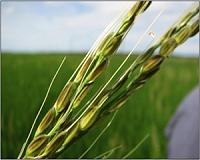 |
Corvallis, Ore. (UPI) Nov 11, 2010 An invasive species of "devil" weed in range lands in the western United States could make millions of acres of grazing land worthless, researchers say. Researchers at Oregon State University say the weed knows as medusahead has growth advantages over most other grass species that could allow it to continue to spread across much of the West and disrupt native ecosystems, a university release said Thursday. Their study comparing the "relative growth rate" of this invasive annual grass to that of other competing species in natural field conditions found that medusahead has a faster growth rate, a longer period of growth and produced more total biomass than any native grasses. "Medusahead is now spreading at about 12 percent a year over 17 western states," Seema Mangla, a researcher in the OSU College of Forestry, said. "Once established, it's very hard to get rid of. "It displaces native grasses and even other invasive species that animals can still eat," she said. "This is a devil species," she said. Native to the Mediterranean region, medusahead was imported to the United States in the late 1880s. The sharp and twisting points on the tips of medusahead can injure animals and give the plant its name, based on the female monster in Greek mythology who had hair composed of writhing snakes. The plant takes up other soil resources and its deep root system soaks up limited moisture. It creates fuel for wildfires, is virtually inedible and prevents many other plants from germinating, researchers say. Experts at the Oregon Department of Agriculture say once land is invaded by medusahead, it becomes largely worthless, incapable of supporting native animals, birds or livestock.
Share This Article With Planet Earth
Related Links Farming Today - Suppliers and Technology
 Study launched to boost rice production
Study launched to boost rice productionHanoi, Vietnam (UPI) Nov 10, 2010 A $600 million global scheme to boost rice yields was announced in Hanoi Wednesday. Launched by the International Rice Research Institute and the Consultative Group on International Agricultural Research, the Global Rice Science Partnership is expected to lift 150 million people out of poverty by 2035 and prevent the emission of greenhouse gases by an amount equal to 1 billion tons of c ... read more |
|
| The content herein, unless otherwise known to be public domain, are Copyright 1995-2010 - SpaceDaily. AFP and UPI Wire Stories are copyright Agence France-Presse and United Press International. ESA Portal Reports are copyright European Space Agency. All NASA sourced material is public domain. Additional copyrights may apply in whole or part to other bona fide parties. Advertising does not imply endorsement,agreement or approval of any opinions, statements or information provided by SpaceDaily on any Web page published or hosted by SpaceDaily. Privacy Statement |